Introduction
It’s fascinating to step into your shower/bathtub and have hot water instantly available from the tap. How effortless, right? This is possible with a tankless water heater with an efficient heating element. Today, let’s discuss these tankless water heaters and their heating elements.
What is a Tankless Water Heater?
A tankless water heater is a basic heating system that heats water only when needed. It doesn’t use a storage tank like other regular heaters. It just saves you energy and produces hot water on demand. It’s mostly used in hot water faucets.
You don’t need to do anything more than turn on the tap. When you do, cold water first flows through a heat exchanger inside the water heater. While this is ongoing, a heating element heats the water before it comes out. These elements of a water heater could be powered by gas or electricity, depending on your choice. Once you turn off the tap, the heating element shuts off immediately.
These tankless water heaters use efficient heating elements to instantly heat cold water to produce hot water. Now, the whole idea of a tankless water heater is to save you energy and space while providing you with endless hot water, especially if you stay within the flow rating of the heating element heater. Many homes, offices, and industries now install these water heaters because of the several advantages it has over traditional heaters. Some of these advantages are:
-
They are very easy to understand and operate.
-
They have an unmatched energy efficiency. According to the US Department of Energy, tankless water heaters are about 34% more efficient than traditional tank heaters.
-
Tankless water heaters have a longer lifespan compared to other heaters.
-
There’s no standby heat loss or wasted energy from storing hot water that won’t be used. For example, research shows that about $150 is wasted annually on electricity due to the standby heat loss from traditional storage water heaters.
Now, let’s look at all the components that make up a tankless water heater:
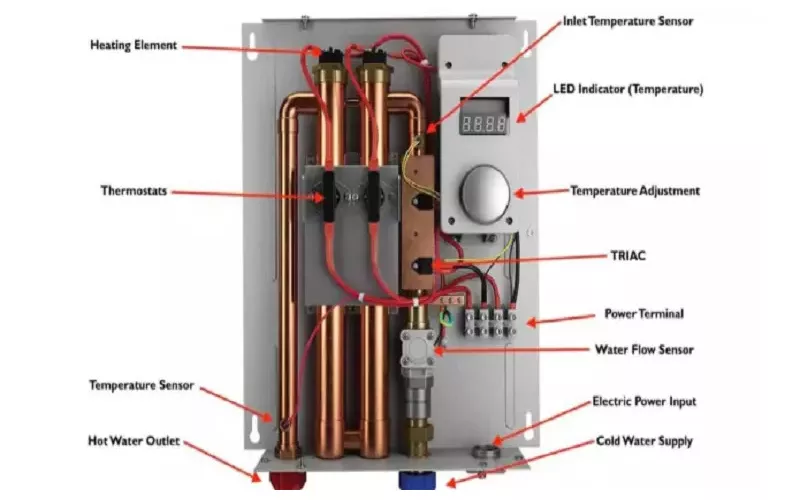
Diagram 1: Component of a Water Heater
-
The heating element for water heater”. (like ceramic heating elements, nichrome wire, etc.)
-
Inlet and outlet pipes that bring in cold water and release the hot water gotten from the heating element for water heater.
-
A flow sensor that detects when water starts flowing.
-
A heat exchanger that transfers heat to the water efficiently.
-
A Control circuit board to monitor and regulate heat properly.
-
Temperature sensor/Thermostat.
-
Safety devices like thermal cutoff switches.
-
Pressure release valves.
-
A suitable casing to provide you with insulation and safety while in use.
It’s interesting to note that ceramic components are chemically inert materials and so they’re non-corrosive in water (let’s say in 80°C water). They won’t form any rust or oxide layers even after years of exposure. While copper components easily get rust within fews weeks/months of exposure to 80°C water. Especially if the water contains dissolved oxygen and chloride ions or is acidic
While deciding on what type of material to use for the components in your tankless water heater, also note - Ceramic components’ unit price are usually around $45 but their lifespan is extended by 50-60%.
Also, see some of the key properties that make tankless water heaters outstanding:
-
Their flow sensors activate around 0.5 to 0.75 L/min.
-
They possess a heating power of about 6 - 27 kW
-
They have a water flow rate of 2-10 L/min.
-
Their temperature rise (temperature difference between inlet and outlet water) is about 25 - 45°C.
-
They have a high energy conversion/efficiency of at least 85 - 98%.
-
They have an operating water pressure of about 0.5 - 1.0 MPa
-
The electrical resistance (per element) is about 10 - 20 Î. Depending on the type and length of the heating material coil.
-
They have a dielectric strength/insulation of about 2.5 kV.
-
The heating element usually has a thermal conductivity of about 11 - 20 W/m·K.
-
They have high strength and a long lifespan. (ranging from 10 - 15 years if you’re able to maintain them properly).
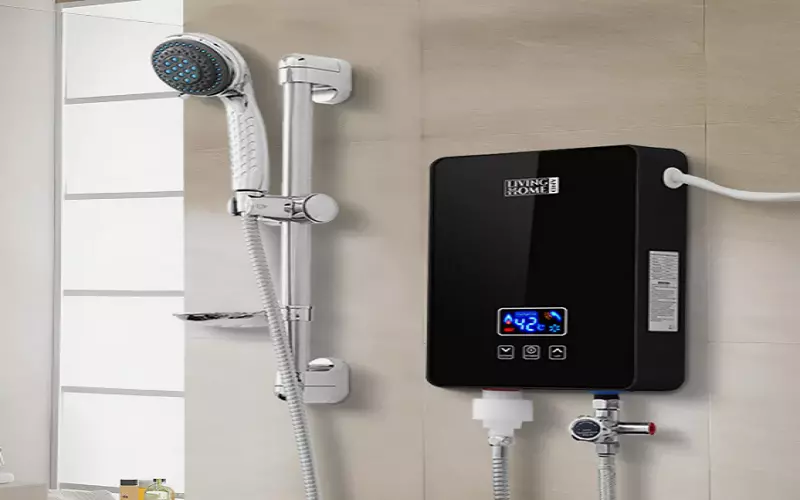
Diagram 2: An electric tankless water heater diagram
How Does a Tankless Water Heater Work?
The chief question most users and young technicians ask is - how does a tankless water heater work?. Now, a tankless water heater does not need a storage tank, which means it works based on the principle of flow-activation. So, how does a tankless water heater work? - Like earlier explained, when you open a hot water tap/faucet, cold water first enters the unit and passes through an already programmed heat exchanger. Once the heater’s flow sensor detects water movement, it instantly triggers the heating element to heat up the water. All these happen within a few seconds before the hot water comes out.
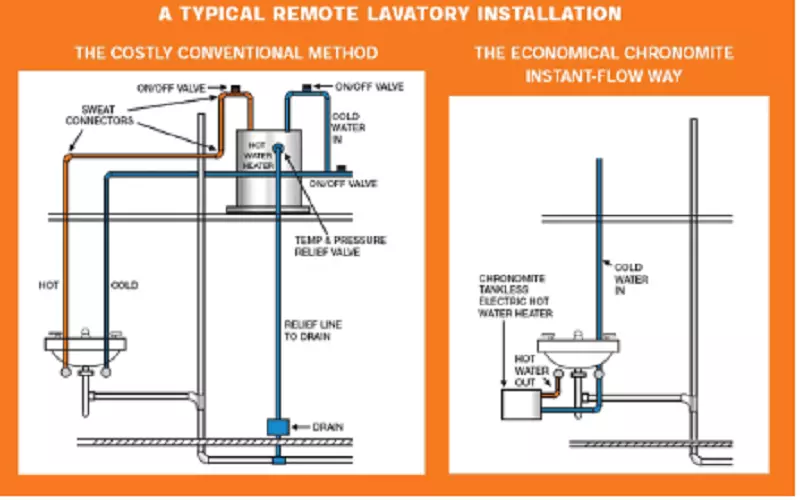
Diagram 3: How an Electric Water Heater Works
The system is designed to maintain a steady temperature by adjusting power. Immediately, you close the tap, the flow stops, and the system shuts down on its own. Yes, so if you’ve been asking - how does a tankless water heater work? You have your answer now, it’s that simple!
What Are the Types of Heating Elements in a Tankless Water Heater?
A tankless water heater requires an efficient heating element to give you maximum performance.
Now, what is the heating element in a tankless water heater? It is the component that directly heats the water as it flows through the unit. It instantly converts electrical energy into heat the moment you open the tap.
It’s a major component of the tankless water heater because it does the actual work of heating water. In fact, it’s been specifically designed to:
-
Heats up very fast (within seconds)
-
Withstand high temperatures (up to 800°C).
Although it’s advisable for you to use temperatures below 600°C in order to extend the water heater’s lifespan. 800°C is the laboratory extreme value.
Also, these elements of water heaters work based on the principle of resistive heating - when electricity passes through the material (like ceramic, nichrome wire, or metal alloys), the resistance causes it to heat up. That heat is transferred to heat up the water (in this case).
There are various types of heating elements to choose from, depending on your choice of materials, the branding, or the energy source. Some of the major ones you can use in your tankless water heaters are:
-
Ceramic heating elements, made from advanced ceramics (silicon carbide, boron nitride, etc.) - These ones are very fast, durable, and efficient.
-
Nichrome heating elements - made from a resistance wire type.
-
Positive Temperature Coefficient (PTC) elements - the self-regulating ceramic masters.
-
Copper heating elements - They possess high thermal conductivity and are very common. An example is the HE 90240 heating element.
-
Quartz tube heating elements
Contact us now at GGSCeramics and order high-quality brands of these heating elements made from PTC, Ceramics, etc. Use them and you’re guaranteed maximum performance especially in tankless water heaters.
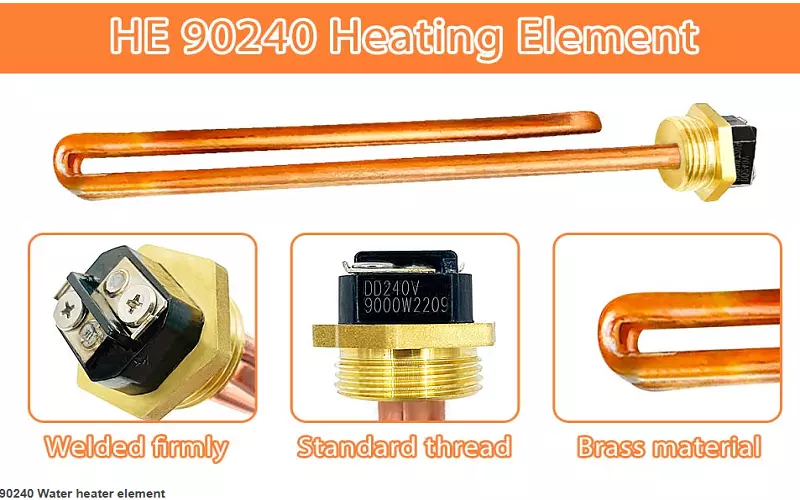
Diagram 4: HE 90240 heating element diagram
Also, note that a good heating element must:
-
Be able to convert electrical energy to heat by resistance.
-
Have a power rating of at least 3 - 9 kW per element, depending on the model.
-
Have an operating voltage of about 220 - 240V AC. (especially for households).
-
Have high surface temperatures reaching 700°C during operation.
Since ceramic heating elements are one of the best for a tankless water heater, let’s see some of the properties.
-
It heats up very quickly (3 - 10seconds).
-
It has operating temperatures ranging from 400 to 800°C.
-
It has a thermal conductivity of 18 - 25W/m.K that guarantees you a very efficient transfer of heat to water.
-
It has a dielectric strength of 10 - 20 kV/mm.
-
It has an electrical resistivity of about 10⁵ - 10⁹ Ω·cm.
-
It has a coefficient of thermal expansion ranging from 6 - 8 × 10⁻⁶ /K. Making it able to comfortably resist cracking under stress/tension.
-
It has a density of about 3.4 - 3.8 g/cm³.
-
It has a specific heat capacity of about 0.8 - 1.0 kJ/kg ·K.
-
It has a compressive strength of about 200 - 2000 MPa, tensile strength of 100 - 300 MPa, and flexural strength of about 150 - 400 MPa.
-
It’s very durable with an average lifespan of about 15,000 - 20,000 hours.
-
It doesn’t rust easily.
How To Replace a Heating Element in a Tankless Water Heater.
Replacing/installing a new heating element in your tankless water heater is a very essential step, especially if:
-
You notice good flow in the water heater, but the water never gets warm.
-
There’s an inconsistency or no hot water production.
-
You notice an unusual noise or sizzling sound. (Maybe due to burnout or mineral buildup on the heating element).
Before we go further, you must note that installation by non-professionals may lead to electric shock or explosion. So it’s recommended to be performed by certified technicians.”
Now, here’s a step-by-step guide on replacing the heating element:
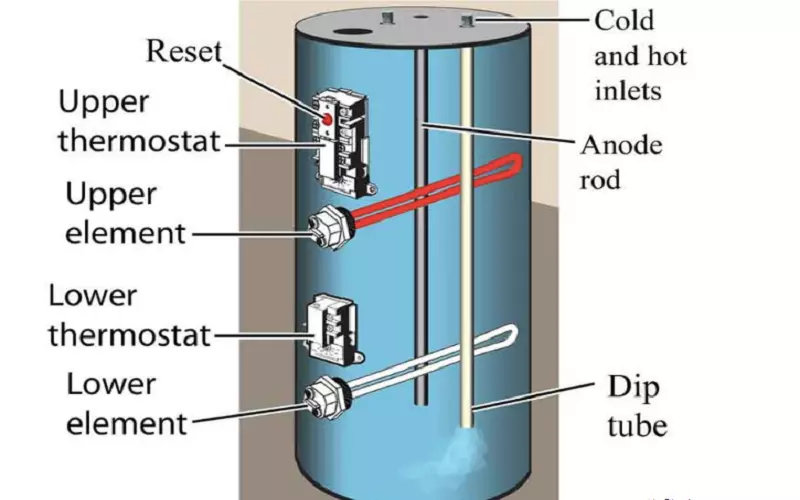
Diagram 5: Replacing a heating Element
-
Disconnect the power & water supply (close the main water inlet valve).
-
Release pressure by opening the hot water tap and draining the heater.
-
Use a screwdriver to remove the cover panel and locate the heating element.
-
Loosen the screws and disconnect the wires of the old heating element.
-
Now, you can remove the old element of the water heater by pulling it out carefully.
-
Before installing the new heating element, check the gasket to see if it’s worn out. You should replace it if it’s worn out.
-
Carefully install the new heating element by inserting it in its place and tightening it with the screws. Check the label properly to ensure it’s the same voltage and wattage rating with the previously used.
-
You can now reconnect the wires you previously disconnected.
-
Now, refill and test the heating element. To begin, open the water inlet and fill up the heater.
-
Then switch on the power and observe to ensure it’s working well. Don’t forget to check for errors or leaks.
Safety Precautions to Take While Replacing Heating Elements
These are some safety tips you should follow as you replace the heating element in your tankless water heater:
-
Before doing anything, always ensure you switch off/disconnect power from the tankless water heater.
-
To avoid burning yourself, allow the element of the water heater to cool for at least 20 - 30 minutes.
-
Also, ensure that there is no source of water supply turned on, to prevent electrical shorts/shock.
-
While operating the tankless water heater, use well-insulated materials, especially for the wiring connections.
-
Before putting on the water heater, ensure every component is tightly fitted and properly sealed.
-
Do not overtighten the screws after installing the new heating element for the water heater.
All these procedures to install and the safety precautions comply with ASME A112.18.1-2025 Safety standards.
Frequently Asked Questions
What causes a tankless water heater to suddenly stop producing hot water?
It could be a result of the element of the water heater getting bad or an electrical fault. So, it’s best you cross-check or call an engineer for proper examination.
How long should a ceramic heating element in a tankless water heater last?
Depending on the quality and how well you use/maintain it, it should give you at least 10 years of service.
How can I prevent my heating element from burning out?
It’s simple. Ensure you flush the system regularly, avoid hard water, and never run the heating element without proper water flow.
Conclusion
Tankless water heaters are absolutely the best and most efficient at producing hot water. Their amazing properties like excellent thermal conductivity and dielectric strength, guarantees an endless supply of hot water. As long as you install/use the required heating elements, your heating needs are sure to be met fast and elegantly. You should try them out now!